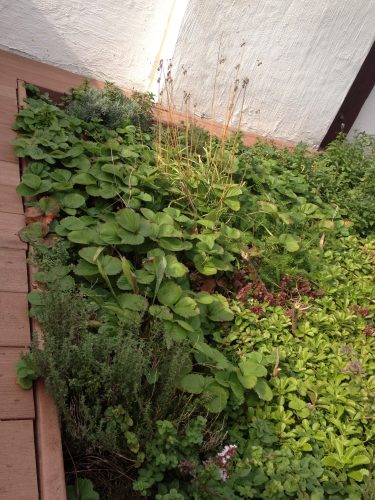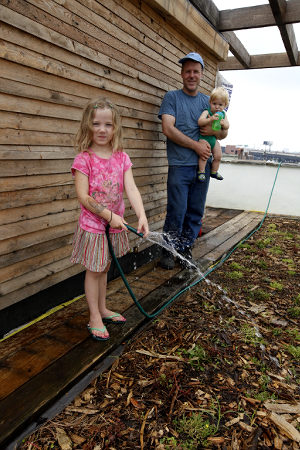Whenever we install a green roof we strongly recommend the client pay for ongoing maintenance, regardless of whether they do it with Eco Brooklyn. It is not like caring for a green roof is difficult, in fact it is very easy and pleasurable, but if you don’t there could be problems.

Green Roofs, like all gardens, require some amount of maintenance and, like gardens, the type of green roof you have will determine the amount of maintenance it needs. Intensive green roofs (more than 6″) will require much more time and effort than extensive ones. So as there is no simple answer to the question of “how to maintain a green roof,” here are some general green roof maintenance tips.
General Green Roof Maintenance and Care
Keep the drainage areas clear of plants. The border around the edge of the roof and the areas around drain outlets and other roof penetrations should be kept clear of all plant life and vegetation. Plants growing too close to the drain will clog it up, causing possible leaks and in stress to the building structure. If plants grow near roof penetrations it could cause a leak, or it could make it hard for maintenance. Biannual weeding should suffice.
Add compost biannually. Organic mater in growing media decomposes over time. It gets absorbed by plants and gets washed away. Nutrient-rich compost should be added to the roof garden in spring and autumn. This provides plants with important nutrients and replenishes the soil. How much really depends. A rough rule of thumb we use is to add 1/4″ of compost, making sure it does not cover too much the existing plants.
Weed out unwanted plants, also known as volunteer plants. Being on a roof, seeds dropped by birds or carried by the wind inevitably find their way into your roof garden. Some of the seedlings are fine and can be left alone. It’s your call. Others, such as a budding oak tree, are not desirable for obvious reasons. Smaller bushes and plants are also not desirable because they may have aggressive roots that may cause leaks. Monthly walk-throughs should be scheduled to monitor the types of vegetation growing on your roof.
At the very least a thorough weeding should be done in the spring to get them as they are freshly coming out of the soil. And then another weeding should be done in the summer just before the weeds get a chance to spread their billions of seeds.
The best practice is to also just weed a little every time you see one. It takes two seconds. Be sure to remove the weed from the roof. Throwing it on the soil could release its seeds.

Green roofs should be watered as little as possible for ecological reasons. But there are times when it is so hot and dry that some water may save them. Experiment with plant types and, depending on how much rain you get, try to get to the point where you don’t have to water your roof at all. When it does become necessary to water your plants, err on the side of under watering. Also, if your roof garden is on a pitched roof, begin watering at the top of the roof to the water can trickle down through the plants at the bottom, which may not need any water at all.
Watch out for pests and diseases. Keep an eye out for pests and diseases that may come to your roof garden. While green roofs are designed to attract insects and increase biodiversity, sometimes unwanted insects come along. This is rare given the harsh environment up there. Pests can find much more pleasant places to bother.
If you are at all inclined, keep a detailed maintenance log/diary. Schedule when you’re going to do these checkups (and follow through!) and keep and detailed record of your findings. This will also help you see what plants do best in your roof’s environment. This is optional. Maintenance is really pretty simple and doesn’t need much except some common sense.
